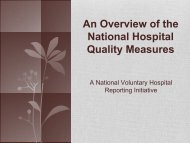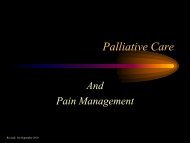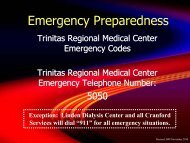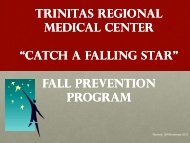Infection Control - Trinitas Hospital
Infection Control - Trinitas Hospital
Infection Control - Trinitas Hospital
Create successful ePaper yourself
Turn your PDF publications into a flip-book with our unique Google optimized e-Paper software.
<strong>Infection</strong> <strong>Control</strong><br />
Revised: BW/September 2010
Standard Precautions<br />
Applies to all patients at all times<br />
Wear gloves with all blood and body<br />
fluid contact<br />
Wash hands after removing gloves<br />
Wear gowns, masks and eye protection if<br />
splashing of body fluids is likely
Hand Hygiene<br />
Always wash hands<br />
Before and after patient contact<br />
Before putting on sterile gloves<br />
After removing gloves<br />
Before eating<br />
Before and after using the<br />
restroom<br />
Alcohol-based hand rubs:<br />
May be used instead of soap and water if hands<br />
are not visibly soiled<br />
Handwashing is the #1 way to prevent the spread of infection<br />
from person to person!
Proper Hand Hygiene includes:<br />
Remove rings<br />
Wet hands<br />
Apply soap<br />
Scrub well for at least 15 – 20 seconds<br />
Rinse well<br />
Dry hands with a paper towel<br />
Turn faucet off with the paper towel
Fingernail No-No’s<br />
Artificial nails, nail extenders, overlays, tips,<br />
wraps, or nail jewelry are NOT to be worn by:<br />
Persons who provide direct patient care<br />
Persons who have contact with patient equipment<br />
Persons who are food handlers<br />
Keep your nails neat and clean!
Protect Yourself from<br />
Bloodborne Pathogens<br />
Standard Precautions<br />
Treat all blood and other<br />
body fluids as if they are<br />
infected<br />
Personal Protective<br />
Equipment<br />
Gown, gloves, masks when<br />
performing any procedure<br />
that is likely to cause<br />
splashes, spray or splatters<br />
of blood or body fluids<br />
Medical Waste<br />
All medical waste is to be<br />
disposed in the red plastic<br />
garbage bags.<br />
Sharps<br />
Never bend, break or recap<br />
contaminated needles<br />
Dispose of all needles in the<br />
Sharps containers located in<br />
all patient care areas<br />
Laundry<br />
Soiled laundry is never<br />
separated<br />
Place all laundry in soiled<br />
laundry hampers<br />
Use Standard Precautions<br />
when handling all soiled<br />
laundry.
What to do in the event of a needle<br />
stick or other body fluid exposure:<br />
Step 1:<br />
Decontaminate skin –<br />
• Wash with soap and water.<br />
Eyes, nose and mouth –<br />
• Rinse with water or saline<br />
Step 2<br />
Report to supervisor and<br />
complete an employee injury<br />
report<br />
Employee Health Services<br />
Step 3<br />
Call Employee Health<br />
• Monday – Friday<br />
7AM – 3PM.<br />
If Employee Health is<br />
closed go directly to the<br />
Emergency Room<br />
Step 4<br />
Follow up with Employee<br />
Health Services<br />
994-5368<br />
210 Williamson Street – 1 st Floor<br />
Administrative Services Building
Transmission Based Precautions<br />
Used in addition to Standard Precautions for patients<br />
who have highly contagious diseases.<br />
Airborne Precautions<br />
Used for diseases that are transmitted through the air.<br />
Isolate the patient<br />
Wear approved respiratory<br />
protection (respirators)<br />
Negative Pressure Rooms<br />
TB, Rubeola and Varicella
Transmission Based Precautions<br />
Droplet Precautions:<br />
Used for diseases that are transmitted short<br />
distances by large droplets<br />
Isolate the Patient<br />
Wear a surgical mask<br />
Meningitis, Pertussis,<br />
Rubella
Transmission Based Precautions<br />
Contact Precautions:<br />
Used for diseases that can be transmitted by<br />
physical contact with the patient’s skin<br />
Isolate the patient<br />
Wear gloves and gowns,<br />
masks if appropriate<br />
MRSA, VRE, C. difficile
Tuberculosis<br />
Transmission: Airborne<br />
Screening<br />
PPD – Mantoux Skin Test<br />
Chest x-ray<br />
Lab Tests: AFB Smear and<br />
Culture<br />
Signs & Symptoms<br />
Cough, weakness<br />
Decreased appetite<br />
Weight loss<br />
Fever and night sweats<br />
High Risk Procedures<br />
Sputum collection<br />
Sputum induction<br />
Bronchoscopy<br />
High Risk Groups<br />
Persons with HIV<br />
Persons having recent<br />
exposure<br />
Immigrants from Asia, Africa,<br />
and Latin America<br />
Low income, medically underserved<br />
persons<br />
IV drug abusers and alcoholics
Multidrug-Resistant Organisms<br />
(MDROs) include:<br />
MRSA Methicillin<br />
resistant Staphylococcus<br />
aureus<br />
VRE Vancomycin<br />
resistant Enterococcus<br />
ESBL (Extended<br />
Spectrum Beta Lactamase)<br />
producing organisms e.g.<br />
Klebsiella pneumoniae<br />
and Escherichia coli.<br />
Use Contact Precautions<br />
and dedicate noncritical<br />
patient care items like<br />
stethescopes and blood<br />
pressure cuffs.<br />
The best way to<br />
prevent the spread of<br />
MDROs is proper hand<br />
hygiene before and<br />
after patient care!
What Is Respiratory Etiquette?<br />
Cover your mouth and nose<br />
when coughing or sneezing.<br />
Use tissues to contain respiratory<br />
secretions and dispose of them in<br />
the nearest waste receptacle after use.<br />
Wash your hands after having contact<br />
with respiratory secretions and<br />
contaminated objects/materials.










